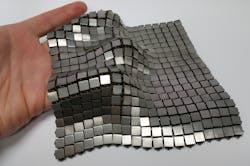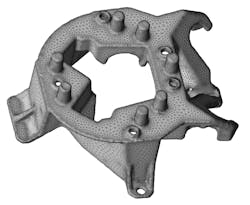In Part 1 of this series, I wrote about 3D printing market predictions, standards, inspection, technology, and materials that had the potential to expand and thrive this year. Part 2 focused on companies that are making that success happen. Finally, this article will conclude with a review of what worked in 2018 and what will be the drivers for 3D printing this year.
It is difficult to cover everything in 3D printing. This is why access to reports, e-books, and white papers can help cover larger areas of the industry, while offering in-depth details. The Wohler’s Report and SmarTech Publishing tend to provide large reports that offer a lot of value. However, these industrial reports can be costly. There are other companies that have blogs, e-books, and whitepapers, but then you must be careful about biases. The following is a quick summary of some of the information from the reports, press releases, and e-books I was sent around the end of 2018 that offered a look into 2019.
Last December, SmarTech Publishing issued its 2019 Additive Manufacturing Market Outlook and Summary Report, which estimated the 3D printing industry grew 24% in 2018 for a total market of $9.3 Billion.
From the Report
In 2018, the additive manufacturing market appears to have regained an important element in its evolution: balanced growth. All segments appear to now be progressing and growing in similar fashion, with shared goals and solutions. This positive development is observed in entities such as 3D Systems and Stratasys seeing more consistently positive growth, which results in a significantly more complex competitive landscape than prior years. In addition, the hard-won successes of these two companies in 2018 helped contribute to the polymer 3D printing segment growing to an estimated around $5.5 billion.
JPL is experimenting with 3D printing. Experts say if we are ever going to get to Mars, 3D printing will be necessary to make the most efficient use of resources. It has even been proposed to use Martian water (as ice) and soil with a 3D printing rover to build living spaces on the new world.
Market success in 2018 has been predicated on two driving trends. The first is the effect of a rapid strategic importance placed on additive manufacturing by large multinational corporations spanning the global chemical and materials communities to developers of traditional machine tools and industrial lasers. Second is the continued efforts of the industry to focus their strategies on applications—especially ones which provide growth that is largely complimentary (not competitive) with existing manufacturing processes and machine tools.
Moving into 2019, the report highlights the top 5 most influential market engagements and moves believed to have profound effects on the industry this year and beyond. Examples include…
- HP’s willingness to bet on its own technology for manufacturing large quantities of parts for its own printers using its own 3D printing process.
- The startup Velo3D’s unveiling of its proprietary laser powder bed fusion technology.
- The release of the Arcam Spectra-H high temperature electron beam melting system.
- Carbon’s production-friendly material pricing strategy.
All identified top 5 metrics are analyzed in the report in terms of future impact to the industry.
The Pan-Industrial Revolution
It’s not all about reports and white papers. Last year the book The Pan-Industrial Revolution was published. Written by Richard D’Aveni, a professor of strategy at Dartmouth College, the book highlights large multinational corporations moving towards digital manufacturing. A large part of this includes platforms built on 3D printing. The book describes how new manufacturing titans will transform the world with 3D printing and advanced connected platforms that provide real-time reaction speed and highly-flexible abilities.
Oak Ridge National Laboratory presented multiple 3D printed replicas at this year’s IMTS. 3D printing composites in large platforms is showing up more at shows like these.
Traditionally large companies would handle large markets. This left smaller niche markets available for smaller companies. The larger companies come with more incumbent inertia, making it more difficult to cover these smaller markets. However, with 3D printing and the Industrial Internet of Things (IIoT), this lack of flexibility is reduced or eliminated. Large corporations moving as fast and react faster than smaller companies will lead to a lot of acquisitions, mergers, partnerships, etc., ultimately creating unstoppable giants.
While this is beyond 2019, some of the foundations for this are being built today. It will be important to be aware of this as we watch 3D printing expand in 2019. This innovative process could start a global shift if D’Aveni is correct.
Advancing CAD
While technology is changing the world, there are no expectations for a groundbreaking innovation this year in the 3D printing space. Most innovations are incremental but help push 3D printing further to disrupt traditional processes. As hardware progresses, the value in software is growing. Efforts to help move digital manufacturing forward will consist of large CAD packages.
New file formats are evolving to include more information about CAD models. 3MF is extendable to support tasks like slicing and job management.
Digital twins will be able to simulate the printing process to ensure a successful printed part. Currently, gaps exist between 3D CAD models and 3D printed parts. CAD solutions do not include the proper tools for a file to be ready for 3D printing. Therefore, sending a CAD file directly to print will usually fail according to an e-book by 3D systems.
2019 will be an interesting time to look at what companies are doing with software. A dedicated and integrated 3D printing software able to handle all preparation and optimization actions will make companies more comfortable integrating the technology in-house. Software packages able to move directly from CAD model to print will make printers easier to use and reduces losses from failed prints.
The 3D Systems eBook covers:
- How the correct software solution can help the profitability of your metal 3D printing business through lowering total cost of operations (TCO).
- What to look for when researching 3D printing software solutions.
Software will help aid the transition to digital manufacturing. Keeping up with the industry and what’s new is valuable and good sources of information is always helpful. Fortunately, recently companies have been moving from blogs that sell the specific company or product to more thought leadership. Protolabs, 3D Systems, Stratasys, Xometry, and more are focusing on education, not necessarily marketing. Again, these resources might be trying to steer you in a particular direction, but don’t throw the baby out with the bathwater—there is still a wealth of information. One thing that might help is to round out your education by reading multiple sources.
Feeling and Surveys
Finally, I received an e-mail with a survey. I often think what people are talking about, or “feel,” is too subjective. However, surveys in the right audience can help minimize hype and offer a glimpse into what people are thinking. A new survey on the state of industrial-scale 3D printing from Essentium “reveals that confidence in, and deployment of industrial-scale 3D printing is at a tipping point amongst 3D production manufacturing stakeholders and decision makers.” Verbiage like tipping point can show you what “feelings” you might find in this survey, but again, don’t throw the baby out with the bathwater. There is still information that can help you gain a better picture of the 3D printing industry.
Some stats from the survey include:
- Over half of the respondents report they are preparing for industrial-scale 3D printing production runs.
- 43% of respondents believe industrial 3D printing will make the mass-customization of products possible.
- 88% believe the economic advantage to manufacturing industries from 3D printing will be in the billions of dollars.
There is also data available from specific platforms such as 3D Hubs and Senvol. Senvol lets users search multiple machines and materials in one space. Having the ability to see multiple companies on a single page help reduce marketing and bias.
Platforms and Information Sharing
Moving forward, platforms such as this one will succeed, and we might see more. 3D Hubs is also a platform, but it allows anyone to access a local printer. This makes 3D printing accessible and maximize a printer’s up-time. Some printer can be expensive, and if they aren’t working, they are costing you money. Filling the time between production or prototype runs with third-party parts can help increase a printer’s return on investment. 3D Hubs also releases a report each quarter with a lot of data, and they don’t keep it to themselves. These reports are not surveys and can give you numbers to attach to “feelings.” The following is from 3D Hubs’ 3D printing trends 2019 report.
Here are some key findings:
- SME’s are the power-users of online 3D printing services, with the vast majority of online 3D printing orders (75%) coming from companies that have less than 100 employees.
- U.S. businesses account for nearly half (45%) of global online 3D printing demand. In Europe, UK firms are the most savvy when it comes to 3D printing, accounting for 18% of the global online 3D printing, ahead of Germany, the Netherlands, and France.
- Prototyping remains the primary application of 3D printing and is universally adopted. Manufacturing of custom tooling is another major application and is seen on the factory floors of companies like BMW, Ford, and Bosch.
If you can get a hold of journals, reports, or non-bias whitepapers and articles absorb as much as you can. 3D printing will continue to disrupt traditional technology in 2019.




